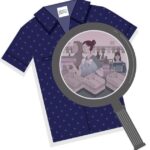Discover Your Signature Look: A Guide to Developing Personal Style
Have you ever admired someone’s style and thought, “They just get it”? That feeling often comes from seeing someone with a strong “signature look” – a unique way of dressing that clearly reflects who they are, without them having to try too hard. Developing your own personal style isn’t about chasing every trend; it’s about understanding yourself, your preferences, and what makes you feel confident and authentic. It’s a journey of discovery, and this guide will help you navigate it, step by step.
What is a “Signature Look”?
A signature look isn’t a uniform you wear every day (though for some, it might be!). It’s a cohesive aesthetic that runs through your wardrobe. It’s the recognizable “you” in how you dress, even when you’re wearing different outfits. It’s a combination of colors, silhouettes, textures, and details that make you feel truly comfortable and confident. Think of it as your personal brand, expressed through fashion.
Why Develop a Personal Style?
- Boosts Confidence: When you wear clothes that truly reflect you, you feel more comfortable and confident in your own skin.
- Simplifies Dressing: No more “what to wear?” dilemmas. A defined style streamlines your wardrobe and makes getting ready easier.
- Saves Money: You’ll make fewer impulse purchases and invest in pieces you truly love and will wear repeatedly.
- Expresses Authenticity: Your clothes become a powerful, non-verbal way to communicate who you are to the world.
- Timeless Appeal: A strong personal style transcends fleeting trends, making your look enduringly chic.
Step 1: Self-Reflection – Who Are You?
The journey to your signature look starts inward. Fashion is self-expression, so you need to understand what you want to express.
- Assess Your Lifestyle:
- What do you do daily? (e.g., office work, remote work, stay-at-home parent, student, artist, outdoorsy).
- What activities do you do regularly? (e.g., formal events, casual outings, gym, hobbies).
- Your wardrobe should serve your life. If you spend 80% of your time in casual settings, your wardrobe should reflect that balance.
- Define Your Personality & Values:
- How would you describe yourself? (e.g., creative, minimalist, bold, quiet, adventurous, sophisticated, playful, classic).
- What are your core values? (e.g., comfort, sustainability, luxury, practicality, uniqueness, professionalism).
- Your clothes should align with these. If you value comfort, tight, restrictive clothing won’t be part of your signature. If sustainability is key, you’ll favor ethical brands and timeless pieces.
- Identify Your Comfort Zones & Discomfort Zones:
- What fabrics do you love? (e.g., soft knits, crisp cotton, flowing silk, sturdy denim).
- What silhouettes feel best on you? (e.g., fitted, oversized, A-line, straight).
- What colors make you feel good? (e.g., neutrals, pastels, brights, jewel tones).
- What do you absolutely hate wearing? (e.g., scratchy fabrics, specific necklines, certain shoe types). Don’t force yourself into something just because it’s trendy.
Step 2: Seek Inspiration – What Do You Love?
Once you have a better sense of yourself, look outwards for inspiration.
- Create a Mood Board (Digital or Physical):
- Pinterest is your best friend here! Create a “My Style” board.
- Collect images of:
- Outfits you admire (on celebrities, influencers, friends).
- Color palettes you’re drawn to (from art, nature, interiors).
- Specific garments or accessories you love.
- Textures, patterns, and even atmospheres that resonate with you.
- Don’t just copy; understand why you like something. Is it the color? The fit? The overall mood?
- Study Your Style Icons:
- Who are the people whose style you consistently admire? It could be anyone from Audrey Hepburn to a favorite fashion blogger.
- Analyze their look: What elements are consistent? Do they favor certain colors, silhouettes, or accessories? How do they mix casual and formal?
- Explore Different Aesthetics:
- Look up various fashion aesthetics (e.g., minimalist, bohemian, preppy, grunge, classic, streetwear, dark academia, coquette).
- Do any of them resonate with your personality or lifestyle? You might find you blend elements from several.
Step 3: Curate Your Closet – What Do You Have?
Your current wardrobe is the starting point for your new style.
- The Wardrobe Edit (The “Keep, Donate, Mend, Toss” Method):
- Take everything out of your closet.
- Keep: Items you love, that fit well, that you wear often, and that align with your new style vision.
- Donate/Sell: Items that don’t fit, you haven’t worn in a year, or don’t align with your desired style.
- Mend: Items that you love but need a small repair (button, hem, seam). Get them fixed!
- Toss: Items that are stained, torn beyond repair, or truly worn out.
- Identify Gaps and Overlaps:
- Once you’ve edited, what essential pieces are missing? (e.g., a good basic white tee, a versatile blazer).
- Do you have too many similar items? (e.g., five black sweaters that are almost identical).
- Analyze Your “Kept” Pile: What are the common threads? Do you see a pattern in the colors, fabrics, or styles you’ve kept? This is often a good indicator of your inherent style.
Step 4: Build Strategically – Fill the Gaps
Now it’s time to shop, but with purpose.
- Prioritize Essentials: Focus on the foundational pieces that can be mixed and matched (as discussed in “Building Your Perfect Wardrobe” article). These form the core of your signature look.
- Invest in Quality: For essentials, spend a bit more on well-made items that will last. This saves money in the long run.
- Shop Mindfully: Avoid impulse buys. Before purchasing, ask:
- “Does this align with my personal style vision?”
- “Do I already own something similar?”
- “Can I create at least three different outfits with this piece?”
- “Does it fit well and feel comfortable?”
- Embrace Versatility: Choose items that can be dressed up or down, and worn in different seasons. A classic midi skirt, for example, can be styled with sneakers and a tee for day or heels and a silk blouse for evening.
- Color Palette First: Start by building your wardrobe around a core set of neutral colors (black, white, grey, navy, camel, olive, denim). Then, introduce accent colors that make you feel good and complement your skin tone.
Step 5: Experiment and Refine – Wear It!
Developing personal style is an ongoing process of experimentation and refinement.
- Experiment with Combinations: Once you have your core pieces, play around! Try mixing unexpected textures, layering in new ways, or adding different accessories.
- Pay Attention to Details: Small things make a big difference. Think about cuffing sleeves, doing a half-tuck, adding a belt, or choosing the right jewelry. (Refer to “Genius Fashion Hacks” for more ideas!)
- Get Feedback (If You Want): Ask a trusted friend how an outfit looks, but remember, ultimately it’s about how you feel.
- Take Pictures: Sometimes seeing an outfit in a photo can help you identify what works and what doesn’t.
- Embrace Evolution: Your style will naturally evolve as you age, your lifestyle changes, and new trends emerge. Be open to adapting your signature look while staying true to your core aesthetic.
Conclusion: Your Clothes, Your Story
Developing your signature look is more than just about fashion; it’s about understanding yourself and expressing your unique identity to the world. It’s a journey that combines self-reflection, inspiration, strategic shopping, and continuous refinement. By focusing on pieces that flatter your body, align with your personality, and serve your lifestyle, you’ll build a wardrobe that’s not only functional but also deeply personal. When you discover your signature style, getting dressed becomes less of a chore and more of an empowering act of self-expression.


